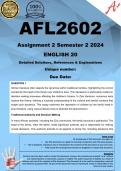AFL2602
Assignment 2 Semester 2 2024
ENGLISH 20
Detailed Solutions, References & Explanations
Unique number:
Due Date:
QUESTION 1
African literature often depicts the dynamics within traditional families, highlighting the control
exerted by the head of the family over children's lives. This repression is particularly evident in
decision-making processes affecting the children’s futures. In Zulu literature, numerous texts
explore this theme, offering a nuanced understanding of the cultural and familial contexts that
shape such dynamics. This essay examines the repression of children by the family head in
Zulu literature, using various literary texts to illustrate this phenomenon.
Traditional Authority and Decision-Making
In many African societies, including the Zulu community, the family structure is patriarchal. The
head of the family, often the father, holds significant authority and is responsible for making
crucial decisions. This authority extends to all aspects of family life, including decisions that
directly affect the children. In the novel Umuzi kaMthaniya by N.S. Zulu, the protagonist
Mthaniya embodies the traditional patriarch who makes unilateral decisions without Terms of use
consulting
By making use of this document you agree to:
his children. His authoritarian• approach createsasaarigid
Use this document guidefamily structure
for learning, where
comparison children’s
and voices
reference purpose,
• Not to duplicate, reproduce and/or misrepresent the contents of this document as your own work,
are suppressed, highlighting the generational divide and the struggle for autonomy faced by
• Fully accept the consequences should you plagiarise or misuse this document.
younger family members
Disclaimer
Extreme care has been used to create this document, however the contents are provided “as is” without
any representations or warranties, express or implied. The author assumes no liability as a result of
reliance and use of the contents of this document. This document is to be used for comparison, research
and reference purposes ONLY. No part of this document may be reproduced, resold or transmitted in any
form or by any means.




